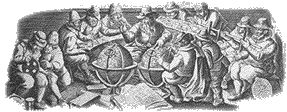 Itineraries
Itineraries


AMONG THE ROADS OF CO D'SA'
Along the roads of "CO DA'S" This itinerary leads along the roads which are North the Castle; the popular tradition remembers these district as the contrade "CO DA'S" (those from the Castle to the centre). Let's go out of Piazza Ducale from the north-west corner: immediately we find Via Caduti per la Liberazione and Via Giorgio Silva, two ancient contrade which have changed their names more than once in the course of centuries. Via Giorgio Silva in the 19th century was known as "la becheria" (for the presence of some butchers) and in the first years of the 20th century it became the "MarcÍ di puž" (the chicken market). Via Caduti per la Liberazione, which was known in the 16th century as the "Cuntrŗ di Marcant" (the merchants' road) in the 19th century was dedicated to Prince Amedeo from Aosta. At the end of this road you will be in a small square with San Francesco's fountain, a work by G. B. Ricci, an artist from Vigevano. On its left there is the Gothic fažade of San Francesco's Church, attributed to Bartolino from Novara.Following Via Dante we get to a crossroads: here is San Bernardo's church the church was built in 1576 after the previous church had been demolished to leave room for the new defensive ramparts built by the Sforzas. Following Corso Cavour at Nr. 32 notable is Palazzo Crespi, built at the end of 1800 by the textile manufacturer Luigi Crespi. "Casa del fascio" in the Fascist period, now contains:
A) CIVIC LIBRARY "LUCIO MASTRONARDI"
B) The CIVIC MUSEUMS "LUIGI BARNI",
C) The GALLERY "CASIMIRO OTTONE"
D) The SHOE MUSEUMS "PIETRO BERTOLINI" .
Leaving Palazzo Crespi and descending along Via Cesarea, the historical "contrada di Cicerino" (Cicerino's contrada), which is mentioned in very ancient documents dating back to one thousand about, you will see the typical Vigevano yards the ("curtass"), real labyrinthine lanes which penetrate into very old buildings and are used as houses or working places even today. At the crossroads turn into Via Merula where at NŪ 26/40 there is the former Monastery of the Our Lady of the Assumption At the end of Via Merula, right in the front, in Corso Vittorio Emanuele II there is the Civic Cagnoni Theatre inaugurato l'11 ottobre 1873.Going left along the Via Vittorio Emanuele II, once "Predalate contrada" you get to the church Madonna della Neve built in 1599 on the spot where was once a very ancient chapel dedicated to the " the Fish's Madonna". After leaving the church follow the road in front of the Sforza Canal and reach the Bishop's Palace ,The palace was started in 1531 by Monsignor Galeazzo Pietra, the first Vigevano bishop. Following Via Cesare Battisti you will be again in Via Vittorio Emanuele II, where, at N. 25 there is the Municipal Palace till 1911 the Civil Hospital. Going upwards along Via Santa Croce you reach Piazza Ducale again, from where our itinerary started.

 |  |
| Back | Home |







